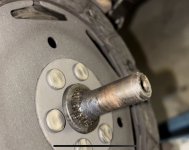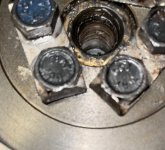Are you certain that it's the spigot bushing? If it was some part of the clutch mechansm itself that was wedging things, my suggestion might cause more damage. Put simply, I think you need to either turn the engine with the gearbox completly locked or vice-versa, and with luck, that would break the "stiction".
If you can lock the flywheel of have a secure way of stopping the front pulley from turning, you could try to gently rock the car backwards and forwards in gear. Alternatively, get the car in gear and put on the handbrake and chock the wheels in both directions and then turn the engine over via the front pulley. You might risk using the starter, with the plugs removed and everything switched off, but there is a danger that if it's really stuck, you might damage something else.
Before doing anything, I would remove the flywheelcover under the car and havve a look to see all is as normal. That might even let you get a lever inside and you could try to force the engine away from the gearbox. Good luck, take things gently.





